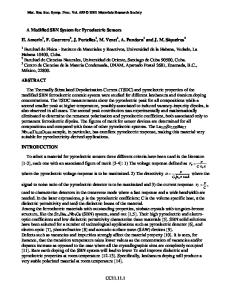Action of Concentrated Heat Sources in a Pyroelectric with Cracks for Constant Temperature of Their Faces
- PDF / 571,067 Bytes
- 8 Pages / 594 x 792 pts Page_size
- 66 Downloads / 278 Views
ACTION OF CONCENTRATED HEAT SOURCES IN A PYROELECTRIC WITH CRACKS FOR CONSTANT TEMPERATURE OF THEIR FACES Ya. М. Pasternak,1,2 H. Т. Sulym,3 and R. М. Pasternak1
UDC 539.3
On the basis of the general integral equations of thermoelectroelasticity deduced earlier for bodies with thin heterogeneities, we construct an analytic solution of the plane problem for a pyroelectric body containing a crack whose faces are kept at a constant temperature under the action of a concentrated heat source lying on the continuation of its axis. By using the principle of self-similarity, we establish the conditions under which the steady-state mode of heat conduction is attained. Compact solutions are obtained for the intensity factors of heat flows, stresses, and electric displacements. The numerical analysis of the results is performed. Keywords: crack, thermoelectroelasticity, heat source, intensity factors.
The problems of thermoelasticity and thermoelectroelasticity of bodies with defects attract the increasing attention of the researchers due to their practical importance because the influence of the fields of different physical nature on the development of cracks turns out to be very important. Thus, in particular, the plane problems of thermoelasticity for isotropic piecewise-homogeneous bodies with heat-insulated cracks were considered in [1–4]. The problems of thermoelasticity of piecewise-homogeneous bodies with cracks and thin deformable inclusions [5] and the anisotropic thermoelastic media with cracks whose faces have constant temperatures of the opposite signs were also investigated [6]. The problems of thermoelectroelasticity of anisotropic bodies are much more complicated than pure thermoelastic problems and the necessity of taking into account the action of concentrated factors makes them even more complicated. As a result, at present, we know only several closed analytic solutions of the simplest problems and a small number of numerical-analytic investigations of somewhat more complicated examples. In particular, the numerical investigation of the problems posed for pyroelectric bodies with cracks whose faces are kept at certain constant temperatures under the action of concentrated heat sources was performed by using complex Lekhnitskii-type potentials in [7, 8]. On the basis of the extended Stroh formalism, some individual fundamental solutions were constructed for magnetoelectroelastic bodies with heterogeneities (cracks, globular inclusions, and holes) under the action of concentrated heat sources [9]. The singular integral equations of thermoelectroelasticity for anisotropic bodies that do not contain volume integrals over the domain occupied by the body were obtained in [10, 11]. For two-dimensional problems, a series of numerical solutions was constructed for pyroelectric bodies with cracks and thin deformable inclusions under homogeneous and mixed thermal boundary conditions imposed on the boundary of the body or on the boundary of the inclusion. 1 2 3
Lutsk National Technical University, Lutsk, Ukraine.
C
Data Loading...










